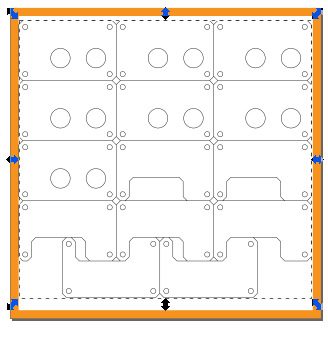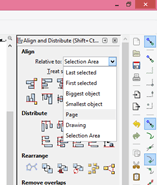

GIMP can be used to create etch designs only.
#Inkscape laser cutting free#
It's like the 100% free and open source cousin of Adobe Photoshop.
#Inkscape laser cutting software#
GNU Image Manipulation Program (GIMP) is photo-editing software for creating or modifying raster images (jpg, png, bmp, etc).Inkscape can be used to create designs that can include both etches and cuts in a single file. It's like the 100% free and open source cousin of Adobe Illustrator. Inkscape is illustration software for creating or modifying vector images.If you have questions about merging and welding shapes with other softwares, we are continually updating our blog with resources to help you get the most out of your SendCutSend experience.The Lightburn software is great for interfacing to the laser cutter and has basic drawing tools, but you are generally better of doing your designs in dedicated design software. This is just to make sure the exclusion tool didn’t leave anything behind or create any empty objects. I’m going to view the file in “ outline display” mode one last time and move the object around. Then under the “ path” menu, I’m selecting “ exclusion.” The exclusion tool will cut the white shapes out of the gray, creating one cohesive shape that I can send to the laser. We’re going to start by using the “ edit path by nodes tool” (F2) to select all the shapes. I need to cut the white shapes out of the laser gun in Inkscape so when the part is sent to the laser, the correct paths are recognized for cutting. Now if I select all and apply black, it becomes obvious that there aren’t actually cut lines for the holes in the part. The white shapes are what I want to have cut out of the material by the laser-cutter. To start, I basically have one gray shape that has white shapes layered on top. For this example we’ll just look at the laser gun in our design. The “ division” and “ exclude” tools let you reverse one shape out of another while making it all one object. Now is a good time to talk about using this. The example above was pretty simple because I had already made use of the “exclude” tool.

The lines should no longer be overlapping and the object will be laser cut cleanly without any unwanted cuts. You can double-check that your objects have merged correctly by viewing the file in “ outline display mode” again. Using the “ edit path by nodes” tool (F2) again, I’ll select all the shapes. Now that I have a continuous path I can merge my shapes. In the top toolbar, I’ll click the “ join selected nodes” button.

Using the “ edit path by nodes” tool (F2), I will select the two nodes that I want to join. I’ll need to fix those issues before I send this file to the laser.īefore I combine my shapes, I need to fix that open contour, or broken path. I have multiple objects all piled on top of one another, and I see a couple of stray points, an open contour, and a line that isn’t connected. See all those overlapping lines? The laser will attempt to cut all of them even though they’re overlapping and it’s not possible. Looks pretty good, right? Well, before we get ahead of ourselves, let’s view our design in “ outline display mode.” I suggest doing this numerous times as you’re designing and getting your file ready for laser cutting. Pretend you’re me and you want your logo cut out on a nice little stand. Tidying up your objects for the purpose of laser cutting is best shown by example. These things are super easy to clean up if you follow our tutorial. The laser will read any path in the file, whether it’s stray or disconnected from the rest of the object, and attempt to laser cut the path, ruining your product in the process. Making sure your objects are combined correctly is important for laser cutting.
#Inkscape laser cutting how to#
In this tutorial we’re going to show you how to unite and exclude objects in Inkscape for laser-cutting.


 0 kommentar(er)
0 kommentar(er)
